-
Countries
-
Data and Analysis
-
Special Focus
-
Crisis Responses
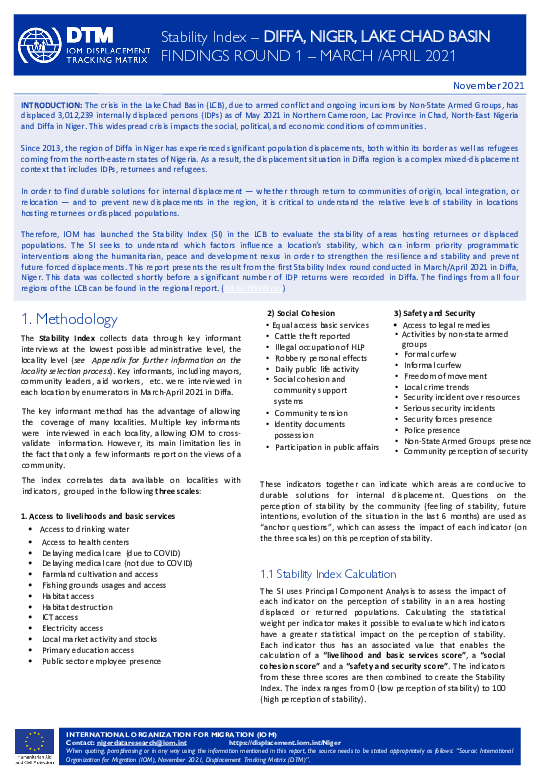
Contact
DTM Niger, NigerDataResearch@iom.int
Language
English
Location
Niger
Period Covered
Mar 01 2021
Apr 30 2021
Activity
- Other
- Mobility Tracking
Since 2013, the region of Diffa in Niger has experienced significant population displacements, both within its border as well as refugees coming from the north-eastern states of Nigeria. As a result, the displacement situation in Diffa region is a complex mixed-displacement context that includes IDPs, returnees and refugees.
In order to find durable solutions for internal displacement — whether through return to communities of origin, local integration, or relocation — and to prevent new displacements in the region, it is critical to understand the relative levels of stability in locations hosting returnees or displaced populations.
Therefore, IOM has launched the Stability Index (SI) in the LCB to evaluate the stability of areas hosting returnees or displaced populations. The SI seeks to understand which factors influence a location's stability, which can inform priority programmatic interventions along the humanitarian, peace and development nexus in order to strengthen the resilience and stability and prevent future forced displacements. This report presents the result from the first Stability Index round conducted in March/April 2021 in Diffa, Niger.
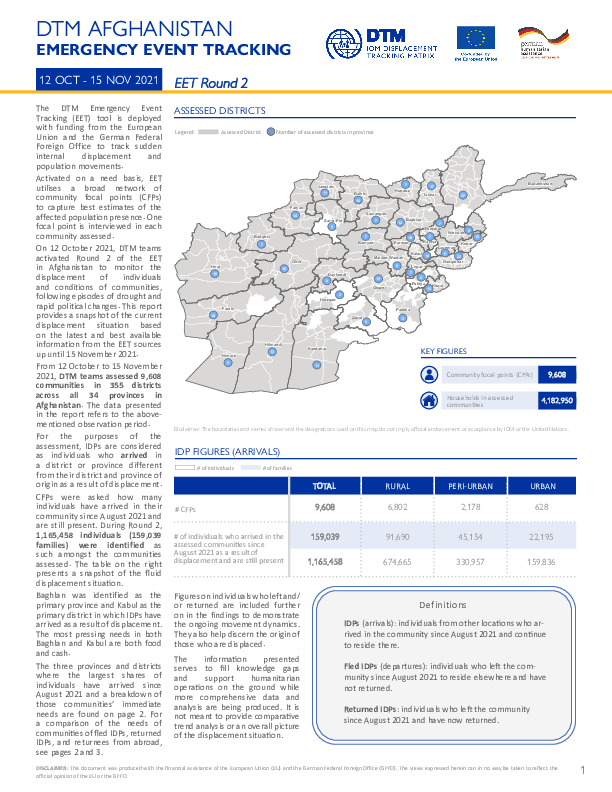
Contact
DTM Afghanistan, DTMKabul@iom.int
Language
English
Location
Afghanistan
Period Covered
Oct 12 2021
Nov 15 2021
Activity
- Event Tracking
The DTM Emergency Event Tracking (EET) tool is deployed with funding from the European Union and the German Federal Foreign Office to track sudden internal displacement and population movements.
Activated on a need basis, EET utilises a broad network of community focal points (CFPs) to capture best estimates of the affected population presence. One focal point is interviewed in each community assessed.
On 12 October 2021, DTM teams activated Round 2 of the EET in Afghanistan to monitor the displacement of individuals and conditions of communities, following episodes of drought and rapid political changes. This report provides a snapshot of the current displacement situation based on the latest and best available information from the EET sources up until 15 November 2021.
From 12 October to 15 November 2021, DTM teams assessed 9,608 communities in 355 districts across all 34 provinces in Afghanistan. The data presented in the report refers to the above-mentioned observation period.
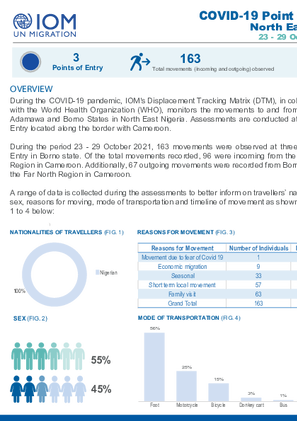
Contact
DTM Nigeria, AllUsersInDTMNigeria@iom.int
Language
English
Location
Nigeria
Period Covered
Oct 23 2021
Oct 29 2021
Activity
- Mobility Tracking
- Baseline Assessment
- Points of Entry (PoE)
During the COVID-19 pandemic, IOM's Displacement Tracking Matrix (DTM), in collaboration with the World Health Organization (WHO), monitors the movements to and from Nigeria's Adamawa and Borno States in North-East Nigeria. Assessments are conducted at Points of Entry located along the border with Cameroon.
During the period 23 - 29 October 2021, 163 movements were observed at three Points of Entry in Borno state. Of the total movements recorded, 96 were incoming from the Far North Region in Cameroon. Additionally, 67 outgoing movements were recorded from Borno State to the Far North Region in Cameroon.
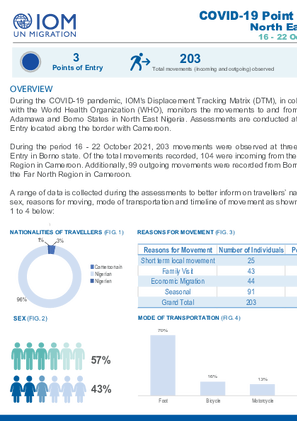
Contact
DTM Nigeria, AllUsersInDTMNigeria@iom.int
Language
English
Location
Nigeria
Period Covered
Oct 16 2021
Oct 22 2021
Activity
- Mobility Tracking
- Baseline Assessment
- Points of Entry (PoE)
During the COVID-19 pandemic, IOM's Displacement Tracking Matrix (DTM), in collaboration with the World Health Organization (WHO), monitors the movements to and from Nigeria's Adamawa and Borno States in North East Nigeria. Assessments are conducted at Points of Entry located along the border with Cameroon.
During the period 16 - 22 October 2021, 203 movements were observed at three Points of Entry in Borno state. Of the total movements recorded, 104 were incoming from the Far North Region in Cameroon. Additionally, 99 outgoing movements were recorded from Borno State to the Far North Region in Cameroon.

Contact
DTM Nigeria, AllUsersInDTMNigeria@iom.int
Language
English
Location
Nigeria
Period Covered
Oct 09 2021
Oct 15 2021
Activity
- Mobility Tracking
- Baseline Assessment
- Points of Entry (PoE)
During the COVID-19 pandemic, IOM's Displacement Tracking Matrix (DTM), in collaboration with the World Health Organization (WHO), monitors the movements to and from Nigeria's Adamawa and Borno States in North East Nigeria. Assessments are conducted at Points of Entry located along the border with Cameroon.
During the period 09 - 15 October 2021, 280 movements were observed at three Points of Entry in Borno state. Of the total movements recorded, 173 were incoming from the Far North Region in Cameroon and 3 were incoming from Chad Republic. Additionally, 102 outgoing movements were recorded from Borno State to the Far North Region in Cameroon and 2
outgoing movements to Chad Republic.

Contact
DTM Mozambique, DTMMozambique@iom.int
Language
English
Location
Mozambique
Period Covered
Aug 17 2021
Aug 31 2021
Activity
- Site Assessment
- Mobility Tracking
De 17 a 31 de Agosto de 2021, em estreita coordenação com o governo provincial de Cabo Delgado, as equipas de Matriz de Monitoria de Deslocamentos (DTM) da Organização Internacional para as Migrações (OIM) realizaram Avaliações Multi Sectoriais de Locais (MSLA) em 53 locais que acolhem 195,250 pessoas deslocadas internamente (PDIs) na província de Cabo Delgado, 1 local com 4.910 deslocados internos na província de Nampula, e 2 locais com 340 deslocados internos na província do Niassa, em resposta aos deslocamentos em massa causados pela situação de insegurança no norte. Em todos os locais, a maioria dos deslocados internos foram deslocados pela situação de insegurança.
Do total de 195.250 indivíduos nos locais avaliados, 54,670 (ou 28%) são mulheres, 39,050 (20%) são homens, e 101.534 (52%) são crianças. Os dados demográficos nas figuras 2 e 3 são uma amostra recolhida através de amostragem aleatória de vinte agregados familiares por local.
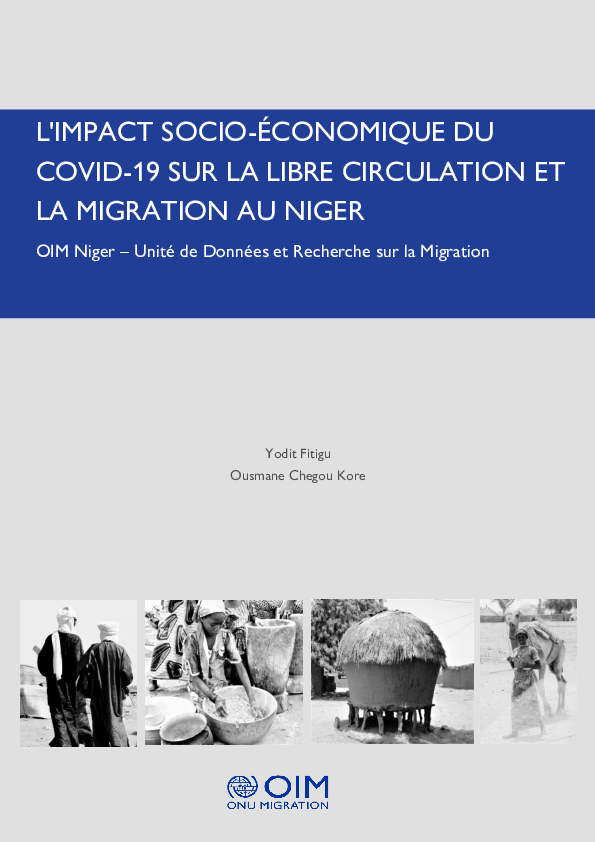
Contact
nigerdataresearch@iom.int ; yfitigu@iom.int
Language
French
Location
Niger
Period Covered
Nov 01 2020
Dec 31 2020
Activity
- Other
Cette recherche, cofinancée par l'Union européenne et la Commission de la CEDEAO à travers le projet « Soutien à la libre circulation des personnes et à la migration en Afrique de l'Ouest », vise à comprendre l'impact socio-économique de COVID-19 sur la libre circulation, les envois de fonds des migrants et le bien-être de leurs ménages, leurs familles et communautés au Niger. Les principaux objectifs comprenaient le profil socio-économique des ménages de migrants, de mieux comprendre comment la migration est liée au bien-être socio-économique des ménages et des communautés au Niger, et pour contribuer à la compréhension sur les tendances migratoires et éclairer les décisions politiques concernant la libre circulation des personnes. La collecte des données a eu lieu entre octobre et novembre 2020 dans les régions d'Agadez, Maradi, Niamey, Tahoua et Zinder. Ce document présente les principaux résultats de l'étude.

Contact
nigerdataresearch@iom.int ; yfitigu@iom.int
Language
English
Location
Niger
Period Covered
Oct 01 2020
Nov 30 2020
Activity
- Survey
This research, co-funded by European Union and ECOWAS Commission through project “Support to Free Movement of Persons and Migration in West Africa”, aims to understand the socio-economic impact of COVID-19 on free movement, migrant remittances and the well-being of migrant households, families, and communities in Niger. The main objectives included determining the socio-economic profile of migrant households, to better understand the ways in which migration is linked to the socio-economic well-being of households and communities of selected areas in Niger, and to contribute to the understanding of migration trends and inform policy decisions regarding the free movement of people. Data collection Took place between October and November 2020 in the regions of Agadez, Maradi, Niamey, Tahoua and Zinder. This document presents the key findings of the study.

Contact
DTM Mozambique, DTMMozambique@iom.int
Language
English
Location
Mozambique
Period Covered
Jun 21 2021
Jul 03 2021
Activity
- Mobility Tracking
De 21 de Junho a 3 de Julho de 2021, em estreita coordenação com o governo provincial de Cabo Delgado, as equipas da Matriz de Monitoria de Deslocamentos (DTM) da Organização Internacional para as Migrações (OIM) realizaram Avaliações Multi-sectoriais de Locais (MSLA) em 42 locais que acolhem 144, 515 deslocados internos (PDIs) na província de Cabo Delgado, 1 local com 3.969 PDIs na província de Nampula, e 2 locais com 360 PDIs na província do Niassa, em resposta aos deslocamentos em massa causados pela situação de insegurança no norte. Em todos os locais, a maioria dos deslocados internos foram deslocados pela situação de insegurança.

Contact
DTM Cameroon, DTMCameroon@iom.int
Language
French
Location
Cameroon
Period Covered
Jul 01 2021
Jul 31 2021
Activity
- Other
Dans le cadre du projet financé par le Fonds de consolidation de la paix des Nations unies dans l’Est, l’Adamaoua et le Nord du Cameroun : « Est, Adamaoua, Nord : réduction des tensions/conflits liés à l’utilisation des ressources naturelles dans le cadre des activités agro-pastorales » entre janvier 2020 et octobre 2021, l’OIM a conduit, à travers son outil de suivi de la transhumance, deux phases de cartographie des pistes de transhumance et infrastructures de transhumance dans les arrondissements cibles du projet, bordant le Tchad et la République centrafricaine :
• Bibemi, Rey-Bouba, Madingring, Touboro dans le Nord ;
• Djohong, Ngaoui, Meiganga dans l’Adamaoua ;
• Garoua Boulai, Ouli, Kette dans l’Est.
Cette cartographie a été conduite par trois partenaires de mise en oeuvre de l’OIM au Cameroun :
• L’Association pour la promotion de l'élevage au Sahel et en Savane (APESS) au Nord,
• CODAS CARITAS dans l’Adamaoua ;
• L’Association Mains solidaires (AMS) à l’Est.
La cartographie a été effectuée à partir des données déjà disponibles auprès du MINEPIA, issues du Livestock and Aquaculture General Census (LAGC) effectué entre 2013 et 2015. L’objectif général de l’exercice de cartographie était compléter et mettre à jour les données disponibles sur les pistes et infrastructures pastorales existantes dans les dix arrondissements ciblés et les mettre à disposition des acteurs de la transhumance et notamment du MINEPIA, partenaire principal du projet.
